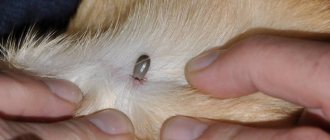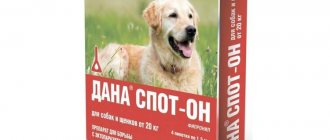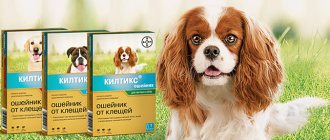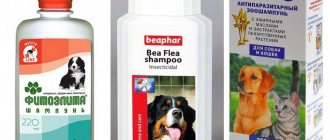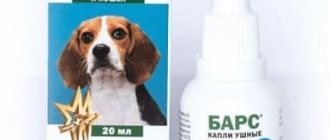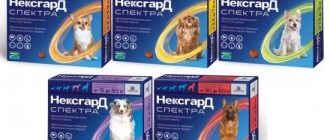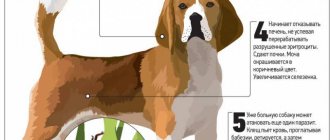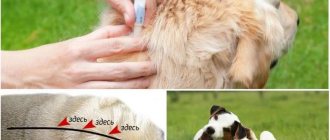Flea drops: advantages and disadvantages
The principle of action of the drugs allows you to quickly and safely rid your pet of blood-sucking ectoparasites. Drops on the withers for dogs against ticks and fleas block the spread of nerve impulses, causing paralysis of the limbs. Here are the main advantages of such drugs:
- Long lasting. Liquid preparations can protect a pet from parasite invasion for a long time. The average frequency of use is once every two months.
- Ease of use. Therapeutic drops are produced in the form of small ampoules. Some of these drugs are packaged in doses, which allows for a complete one-time treatment of the animal.
- Quick impact. From the moment the product is applied to the skin, parasitic insects begin to die within the first day.
- Safe composition. These products are used to externally treat animal hair, where the pet cannot lick it off. This helps prevent toxic compounds from entering your dog's gastrointestinal tract. Even if a few drops get inside, the harmless composition of such insecticides can only cause vomiting.
- The effect of use is visible immediately. Active compounds in flea and tick drops can destroy parasitic insects from the first use, protecting the fur from their penetration for several months.
Among the shortcomings are noted:
- Cannot be used for puppies. These products contain components that can be dangerous for puppies and pregnant dogs.
- Allergic manifestations. In some dogs, some drops cause allergies, dermatitis and skin irritations. Perhaps they are endowed with individual intolerance to the active components of the drugs.
If dogs are allergic to drops against ticks and fleas, you should stop using them, and it is advisable to show the animal to a veterinarian.
Operating principle
Each flea and tick insecticide for dogs has its own principle of action on parasitic insects. The oily structure of such drugs contains various compounds that are dangerous for parasitic insects, causing their paralysis. Many are packaged as ready-to-use plastic pipettes.
What should be included
Most often added to the composition:
- 1. "Invermectin".
A popular toxic compound used to kill flea ticks.
- 2. "Pyriproxyfen."
One of the most active insecticides affecting larvae and adults (adult insects) of fleas. After treating the wool with it, the growth of parasitic larvae is inhibited, which leads to the death of the entire flea population.
- 3. "Fipronil".
An insecticidal agent that is safe against many warm-blooded animals. When it penetrates into the digestive tract of parasites, their paralysis begins, causing rapid death.
- 4. "Permethrin".
A powerful compound that destroys the nervous system of parasitic animals. Safe for dogs due to its rapid ability to break down before entering the blood.
It is not recommended to wash the dog for two days after the wool has been treated.
The speed and effectiveness of the drug
After treating the dog's fur with flea drops, the active compounds of insecticides begin to penetrate through the trachea into the parasites, affecting neurons (nerve cells). Against this background, parasite animals begin to experience paralysis. Due to their inability to move, fleas die by falling from the dog's fur.
In addition to adult insects, many flea drops cope with their larvae, additionally destroying laid eggs. One treatment is enough to completely destroy all parasites.
Duration of exposure
According to user reviews, after the first treatment of wool, fleas are not visible on the second day. One competent use of an insecticide is enough to completely rid your pet of pest animals. Sometimes it is additionally necessary to re-treat the wool for preventive purposes three months after using anti-flea drops.
Instructions for use and application methods
The high quality of flea drops for dogs has been proven by numerous positive user reviews. The instructions included with the medications state:
- method of application;
- single dose;
- frequency of use.
Most often, anti-flea drops are applied to the following areas of the body:
- withers (base of the neck between the shoulder blades);
- spine;
- head (rarely).
The volume of the dose used is based on the weight of the pet. When processing, you should apply the product to the dog's skin, spreading the fur, which helps spread the liquid throughout the body.
Flea insecticides should be applied to areas of the dog’s tongue that are difficult to reach, thereby preventing the pet from licking them. In addition, you should rub the product into the skin with gentle movements.
It is not recommended to treat wounds and abrasions on the dog’s skin with insecticides, as this can cause itching and discomfort for the pet. Apply the anti-flea product to dry, clean skin using gloves.
For the first day after treatment, you should not allow your pet near children and should not stroke its hair. If this happens, hands should be washed immediately with soap. An experienced veterinarian recommends treating the dog's withers with three to four drops of the selected insecticide, rubbing it over the back.
Rating of the best flea and tick remedies
When you go to a veterinary pharmacy, you may encounter a wide variety of medications for ticks and fleas. The rating of flea and tick drops for dogs presented below will help you become familiar with the features of each drug.
"Stronghold"
"Stronghold" is a foreign drug that is produced in pipettes with different concentrations of the active compound. Works well against fleas, suitable for many dog breeds. Apply externally by treating the withers. Its main active compound is selectectin molecules, which are safe for pets.
"Stronghold" does not rid your pet of ixodid ticks!
"Sanofly"
Sanofly is endowed with contact insecticidal and repellent properties. The main active compound is cyfluthrin, which blocks the transmission of nerve impulses in parasitic insects and ticks. It is used externally and belongs to the category of low-hazard substances.
A good drug not only for treatment, but also for the prevention of diseases caused by dipteran parasites. After a single treatment, the protective effect lasts for a calendar month.
"Dana Ultra Neo"
The best drops for fleas and ticks in dogs include Dana Ultra Neo. The main compounds of this drug are the molecules: pyriproxyfen, thiamethoxam and fipronil. Recommended for pets from ten weeks of age.
"IN-AP"
"IN-AP" is a complex remedy for the fight against fleas, enriched with praziquantel, fipronil and aversectin with a complex of auxiliary components. The insectoacaricidal and anthelmintic activity of the drug places it in hazard class III. The medicine pipette should be kept out of the reach of children and pets!
"Advocate"
Advocate drops have a complex effect, which is why they are used in the fight against parasitic and fungal diseases in animals. Suitable for use for preventive purposes.
Hartz
Hartz is enriched with phenothrin, which can kill fleas and other pests from dog fur. The waterproof product protects animal fur for a month after the first treatment.
"Frontline"
Inexpensive, but high-quality product against fleas and ticks, produced in France. Contains fipronil molecules in high concentrations, which paralyze the activity of parasitic insects.
"Advantix"
Advantix is made from imidacloprid and permethrin. The protective effect of the drug is observed 12 hours after treatment of the wool, lasting up to 6 weeks.
Hartz Ultra Guard
Drops of complex effects applied to the withers of dogs. The duration of protection from the first use reaches 30 days. It is not washed off after application by rain and soap, providing a long-lasting protective effect.
"Rolf Club"
A parasite like a flea is afraid of Rolf Club drops, which effectively protect dogs from them! Merciless to ticks and lice eaters. It is not recommended to use the medicine with other insecticides.
"Prac-tick"
A colorless solution used externally against parasitic insects. Enriched with pyriprole. Apply dropwise to the surface of the skin between the hairs.
"Inspector"
“Inspector” is a universal preparation for blood-sucking insects, produced in Russia. Effective against helminths and many ectoparasites.
"Bravecto"
An insecticidal solution for external use that can paralyze the activity of ticks and other parasitic insects. Has many analogues.
"Leopard"
Russian drug enriched with three active compounds. Merciless to fleas and ticks. The protective barrier after treatment lasts for 2 months.
"It will go bad"
Blokhnet drops contain several active compounds in different concentrations. It is recommended to apply the medicine while wearing special protective equipment, avoiding penetration of the drug onto the mucous membranes of the animal. It is not advisable to apply “Blokhnet” simultaneously with other insecticides.
Folk methods of struggle
If it is not possible to treat your dog with flea medications, you can resort to folk remedies. They are not highly effective, so they are used to prevent infection of the animal. For example, 2-3 drops of any essential oil are applied to the fingers and rubbed into the coat. The strong smell repels fleas. Essential oils of coniferous trees and eucalyptus are most effective.
If the pet lives not in the house, but in a booth, the area around it is treated. To do this, leaves and stems of wormwood, sawdust, and branches of coniferous trees are laid out on the floor and next to the house. To get rid of parasites, you can wash your dog not with shampoo, but with soap based on dust or tar. This method is completely safe, but it has the only drawback - the animal must be treated several times to completely destroy fleas.
For mild damage, use vinegar. It is diluted with warm water in a ratio of 1:3, the wool is washed and left for 15 minutes. Avoid contact of the solution with the eyes and mucous membranes.
Contraindications and side effects
An overdose of the described insecticides leads to the following in your pet:
- depressed state;
- dilated pupils;
- muscle tremors;
- increased salivation.
The presence of such signs signals the need to stop using the drug as soon as possible. The pet should be given plenty of water without gases in order to remove toxic compounds from the body. In rare cases, adverse reactions are observed, expressed in the form of itching and skin redness. They disappear on their own two days after stopping use of the product.
It is not recommended to treat dogs with anti-flea medications in the following cases:
- pregnancy;
- progression of infections in their bodies;
- increased background sensitivity of the body to the composition of the insecticide;
- puppies under 7 weeks;
- individuals weighing up to 1.5 kg.
Flea prevention
It is almost impossible to prevent fleas from appearing on your dog, but you can significantly reduce the likelihood of parasite infection. To do this, you need to follow a number of recommendations:
- when going for a walk, wear a flea collar;
- use medications approved for prophylaxis (for example, injections);
- regularly treat the place where the pet lives, its bedding, with appropriate pest control agents;
- avoid contact between your pet and unfamiliar relatives;
- keep the dog clean, monitor the condition of the coat;
- do not walk in places known to be inhabited by fleas (basements, abandoned areas).
What means to remove fleas from a dog is up to each owner to decide according to his or her capabilities. The main thing is to notice the problem in a timely manner and prevent the proliferation of insects.
Medicine prices
Effective medicines against parasites have different cost ranges: from 200 rubles to 600 rubles, depending on the manufacturer and volume. Domestic drugs are more affordable in cost, not inferior in quality to their foreign counterparts.
Flea drops are effective and effective remedies for pets. Before using them, you should read the included instructions or consult a veterinarian, since many of these products are contraindicated for puppies.
Rating of the most effective flea and tick treatments for dogs
Causes of fleas in dogs
To reduce the risk of flea infestation, dog owners need to know where danger awaits their pets.
So, how can a dog become infected:
- Through direct contact with a sick animal.
- Being in a place where an infected animal passed. This could be an apartment, an entrance, an elevator, public transport.
- Through poultry droppings.
- On the hunt, tearing open the burrows of wild animals or destroying bird nests.
- On a walk. Fleas and their larvae can be found in grass, fallen leaves, garbage, soil, on plant stems, and on park paths. Adult bloodsuckers quickly jump, landing on the fur of the victim.
- Flea eggs can be brought into the house by dog owners and their guests on outdoor shoes and clothes.
- Puppies are at risk of infection from a sick mother.
Secondary infection is possible from the dog’s bedding and sleeping area, floor coverings and upholstery of upholstered furniture. Flea larvae may remain in all these places, so during treatment of the dog, the bedding must be completely replaced, and its habitat, carpets and furniture must be treated with special compounds.
